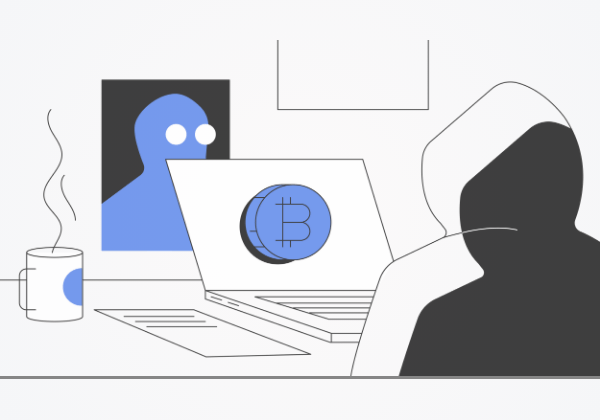
A Guide To Cryptojacking: Detection, Prevention and Protection against Cryptojacking Attacks

With the growth of various forms of cryptocurrencies and their increasing value, cybercriminals are fast moving their focus from ransomware to cryptojacking due to the reduced risk and larger possibility for financial gain. Cryptojacking, which is less difficult and less detectable than ransomware assaults, allows attackers to mine for cryptocurrencies using compromised computing devices and networks.
Cryptojacking, also known as cryptomining, is a new online threat that focuses on cryptocurrency on computers, mobile devices, and data networks. This approach mines all kinds of online currency using a machine’s own resources, takes over web browsers, targets small cryptocurrency farms, and compromises a variety of devices.
The main motivation for cryptojacking techniques is to exploit weaknesses in network infrastructure and obtain as much cryptocurrency as possible before being discovered. However, unlike many other online risks, cryptojacking can go completely undetected by users. And, in the age of COVID-19, when more people than ever are at home and online, purchasing more items using their phones and laptops, the potential of new cryptojacking attempts is growing.
Have you ever noticed that your computer is running slowly while viewing certain websites, or that the processor fan is producing noise and the CPU usage hits 100%? You are most likely a victim of a crypto-jacking attack.
Malicious bitcoin mining was not even identified as a cybersecurity issue just a year ago. In the first quarter of 2018, cryptocurrency miners surpassed ransomware as the most common cyberthreat.
Over the last year, cryptojacking has consistently made news as hackers moved their focus away from traditional approaches and toward this “compromise and profit” strategy. The cryptojacking problem has spread so far that Google has stated that it would block all cryptomining extensions from the Chrome Web Store.
More than 55% of businesses worldwide have been subjected to crypto mining attacks. Cryptojacking occurs everywhere — on websites, servers, PCs, and mobile devices. Mining cryptocurrencies on other people’s devices has surpassed ransomware as the preferred tactic for extorting money online. Gangs are working hard to convince you to click on a malicious link in an email that loads crypto mining malware on your computer; sometimes, they just utilize web ads containing JavaScript code that auto-executes once loaded in the browser.
Here’s what you need to know about cryptojacking, how it affects your online security, and how to safeguard your business and personal computers from being used maliciously.
Cryptocurrency Terminologies You Should Know:
Before we can delve into Cryptojacking in details, let’s look at these basic cryptocurrency terminologies we need to understand:
What is Cryptocurrency?
Cryptocurrencies are digital currencies that are encrypted and can be used to make online payments in exchange for products and services. These cryptocurrencies are formed by the use of blockchain technology, which combines computer programs and computer processing power.
Bitcoin was the first cryptocurrency, and is still one of the most valuable digital currencies. However, while Bitcoin is the most well-known cryptocurrency, it is not anonymous, and payment activity may be tracked as it flows back and forth.
Cryptojackers often concentrate their efforts on cryptocurrencies with more anonymity, such as Monero, Ethereum, and Zcash. Cryptocurrencies have also resulted in the development of ancillary sectors such as cryptocurrency IRAs and crypto digital wallet companies.
What is a Blockchain?
A blockchain is an information chain that timestamps digital transactions so they cannot be duplicated or backdated. The blockchain ledger is accessible to everybody. Each block in a cryptocurrency blockchain stores facts and data about a transaction, such as the recipient and sender, the number of coins involved in the transaction, and a cryptographic hash. Cryptominers generate these hashes by utilizing a hash function, which is a mathematical calculation that turns data into a string of 64 characters.
When a user wishes to transmit money to another user, the transaction is included in a block, which is disseminated around the network and confirmed. Following verification, the block is added to the chain and becomes a permanent record that cannot be altered, with the bitcoin sent to the receiver.
The security of blockchains stems from the fact that there is only one record of the digital transaction, as opposed to two separate databases in the case of ordinary online transactions.
What is Cryptomining?
Cryptomining is the exchange of computer processing cycles for money (cryptocurrency). Cryptomining is the process of adding cryptocurrency transactions to the blockchain ledger, which keeps a time-stamped record of the activity. A cryptocurrency miner refreshes the blockchain and validates that the information is authentic every time a bitcoin transaction occurs.
Cryptominers do this mining process by using high-powered processing servers and specialized hardware to compute and use a hash function that permits the block to join the blockchain, earning their own cryptocurrency in return. While cryptocurrency values are roughly one-third of what they were a year ago, hackers can still make money by cryptojacking, which involves stealing the computational capabilities of unknowing victims with far less chance of detection than other types of cybercrime.
What is Cryptojacking?
Cryptojacking is malicious cryptomining that occurs when cybercriminals gain access to commercial and personal computers, laptops, and mobile devices in order to install software. This program mines for cryptocurrencies or steals cryptocurrency wallets from unsuspecting victims by utilizing the computer’s power and resources. The code is simple to install, runs in the background, and is tough to detect.
Hackers can hijack the resources of any computer with just a few lines of code, leaving unsuspecting users with slower computer response times, increased processing utilization, overheating computer devices, and higher electricity bills. Hackers utilize these resources to steal cryptocurrencies from other digital wallets as well as to use hijacked computers to mine precious coins.
The basic notion behind cryptojacking is that hackers use company and personal computer and device resources to mine for them. Using these hacked machines, cybercriminals siphon the currency they earn or steal into their own digital wallet. These stolen machines are jeopardized by a slowing of CPU function and increased use of electricity for processing.
How CryptoJacking Started and Why It is Becoming a Popular Technique for Cybercriminals
Cryptojacking initially surfaced in September of 2017, when Bitcoin was at its peak. The code released on the website of the company Coinhive, which shut down in early 2019, was meant to be a mining tool for website owners to passively make money — an alternative to displaying ads on their site for income. Cybercriminals, on the other hand, discovered they could use this code to embed their own cryptomining scripts. They were able to mine for the cryptocurrency Monero using the computer power of website users, which has subsequently been implicated in additional cryptojacking investigations.
Varonis Unveils Monero Cryptojacking
Cryptomining malware is getting more difficult to detect. A Varonis Security Research team found a new type of malware that was likely utilized in cryptojacking for Monero coin during a recent examination into a cryptomining infestation. According to research, the virus was causing network slowdowns and instability, both of which are indicators of cryptojacking that may be difficult to detect.
Attackers like Monero for two reasons:
- Monero was meant to be mined using standard PCs — no sophisticated, super-powerful hardware is required.
- Monero, like many other cryptocurrencies, is anonymous, which makes tracing the attacker extremely difficult.
Cryptojacking Poses Less of a Risk to Cybercriminals.
Cryptojacking is getting increasingly popular among cybercriminals. The software utilized is less difficult to deploy and more difficult to detect than traditional hacking approaches. Premade software programs are easily obtained online, and once infected, the cryptomining code operates behind the scenes and can go unnoticed for a long time.
When cryptojacking is identified, it is extremely difficult to track down the hacker. By this point, hackers have freely collected and spent their illegal cryptocurrency earnings, leaving businesses with undesirable repercussions such as slower network performance and the financial impact of having to debug computer failures.
How Does Cryptojacking Work?
Cybercriminals hack devices in order to install cryptojacking software. In the background, the program mines for cryptocurrencies or steals from cryptocurrency wallets. Unknown to the victims, their devices are used normally, though they may notice reduced performance or delays.
Hackers have two major methods for accessing a victim’s device and secretly mining cryptocurrencies:
- By convincing the victim to click on a malicious link in an email, cryptomining malware is loaded into the computer.
- By infecting a website or online ad with JavaScript code that executes automatically once the victim’s browser is loaded.
Hackers frequently employ both approaches in order to maximize their profit. In both situations, the malware installs the cryptojacking script on the victim’s device, which runs in the background while the victim works. Regardless of the approach chosen, the script does complicated mathematical problems on the victims’ devices and transmits the results to a server controlled by the hacker.
Cryptojacking scripts, unlike other forms of malware, do not harm computers or the data of victims. They do, however, steal computer processing resources. Slower computer performance may just be a nuisance for individual users. However, cryptojacking is a problem for businesses since companies with a large number of cryptojacked systems pay real costs. As an example:
- The use of help desk and IT resources to troubleshoot performance issues and replace components or systems in the goal of resolving the issue.
- Increased electricity costs.
Some cryptomining programs include worming capabilities, allowing them to infect other network devices and servers. This makes them more difficult to detect and eliminate. These scripts may also check to determine if the device has previously been infected with rival cryptomining malware. If the script detects another cryptominer, it disables it.
In the early days of cryptomining, several online publishers attempted to monetise their traffic by requesting permission from users to mine for cryptocurrencies while on their site. They framed it as a fair trade: users would enjoy free material while the sites mined on their computers. On gaming websites, for example, users may remain on the page for some time while the JavaScript code mines for coins. The cryptomining would then stop when they left the site. This strategy can succeed if sites are open about what they are doing. The challenge for users is determining whether or not sites are being truthful.
Malicious versions of cryptomining, known as cryptojacking, do not seek for permission and continue to operate long after you leave the initial site. This is a strategy employed by the proprietors of questionable websites or hackers who have infiltrated reputable websites. Users have no awareness that a website they visited has been mining bitcoin on their computer. The code consumes only enough system resources to go unnoticed. Although the user believes that the visible browser windows have been closed, a hidden one remains active. It is frequently a pop-under that is scaled to fit beneath the taskbar or below the clock.
Cryptojacking may infect Android mobile devices using the same ways that it can infect desktop computers. Some assaults are carried out using a Trojan disguised in a downloaded program. Alternatively, consumers’ phones may be routed to an infected website, which leaves a persistent pop-under. While individual phones have limited processing power, when attacks are carried out in large numbers, they give enough aggregate strength to warrant the cryptojackers’ efforts.
How To Detect Cryptojacking : Identifying the Signs of Cryptojacking
Cryptojacking has the power to disrupt your entire business operation. It can be difficult to determine which of your systems has been compromised. The coding in cryptomining scripts can readily elude discovery, therefore you and your IT team must be exceedingly watchful.
Here are some techniques for detecting cryptojacking before it’s too late:
-
Performance Decline
One of the most common signs of cryptojacking is a decline in the performance of your electronic devices. This encompasses PCs, laptops, tablets, and mobile devices. Slower systems can be the first symptom of cryptomining; train your personnel to report any decrease in processing to IT.
-
Overheating
The resource-intensive technique of cryptojacking can cause computing devices to overheat. This can cause computer harm or limit their lifespan. Fans that run for longer than necessary in an attempt to cool down the system are also related to overheated equipment.
-
Inspect the CPU Usage
You can have your IT team monitor and analyze CPU utilization, or you can do it yourself for personal computers. This can be accomplished by utilizing the Activity Monitor or Task Manager. If there is a spike in CPU utilization when people are on a website with little or no media content, it is a hint that cryptomining scripts are executing.
-
Keep an eye on your websites.
Cybercriminals are hunting for websites where they may embed cryptomining code. Check your own websites on a regular basis for modifications to webpages or other files on the web server. This early identification can keep your systems safe from cryptojacking.
-
Battery Drain
The battery of a compromised device usually drains quickly.
-
Malware Scanning
Malware designed for cryptomining consumes system resources in the same way as cryptojacking scripts do. Malware, like CryptoLocker, can infect computers, encrypt files, and hold them for Bitcoin ransom. Scan your security software for malware to assist in identifying these malicious programs. To identify a cryptojacking assault, you can also use software such as PowerShell.
Tips and Tactics for Preventing Cryptojacking
Although it is difficult to identify whether your computer system has been hijacked by cryptojacking, there are certain precautions you may take to secure your computer and networking systems, as well as your personal crypto-assets:
-
Use a strong cybersecurity software:
A robust cybersecurity software will aid in the detection of threats across the board and can defend against cryptojacking malware. It is far better to install security before becoming a victim, just as it is with all other malware measures. It’s also a good idea to install the most recent software updates and patches for your operating system and other programs, especially web browsers.
-
Be aware of the most recent cryptojacking trends:
Cybercriminals are continuously changing code and devising new delivery ways to install updated scripts into your computer system. Being vigilant and up to date on the newest cybersecurity risks may assist you in detecting cryptojacking on your network and devices, as well as avoiding other forms of cybersecurity attacks.
-
Educate Your IT Workforce
Cryptojacking should be understood and detected by your IT team. They should be alert to the first symptoms of an assault and take prompt action to conduct additional investigation.
-
Educate Your Employees
Employees must notify IT staff when computers are functioning slowly or overheated. Employees must also be trained on cybersecurity issues, such as not clicking on links in emails that run cryptojacking code and only downloading from reputable sources. Personal email on your own devices is subject to the same restriction.
-
Use Anti-Cryptomining Extensions
Web browsers are frequently used to run cryptojacking programs. Browser extensions like minerBlock, No Coin, and Anti Miner may be used to block cryptominers throughout the web.
-
Use Ad-blocking Extensions
Cryptojacking scripts are commonly included in web browsers. Ad-blocking browser extensions can be used to identify and prevent malicious cryptomining code.
-
Disable JavaScript
Disabling JavaScript when surfing the web can help keep cryptojacking malware from infecting your machine. Remember that deactivating JavaScript will prevent you from using many of the functions you use when surfing.
-
Block Websites that are known with Cryptojacking Scripts:
To avoid cryptojacking while browsing websites, ensure that each one is on a properly reviewed whitelist. You can also block cryptojacking-related websites, however this may still expose your device or network to new cryptojacking pages.
In Conclusion:
Cyptojacking is a disruptive and harmful attacking tactic that can result in a variety of negative effects. Your business requires a proactive method to prevent this attack from converting your website or content into a potentially unsafe environment for users.
Businesses should never underestimate the damage that malicious mining can cause. To reduce threats, they must implement dependable security solutions across all devices, including public terminals, IoT devices, and anything else with an internet connection.
To explicitly protect against cryptojacking attacks, it is also required to monitor processor activity across all endpoints, including those hosted in the cloud. Finally, keep an eye out for any frequent queries to IP addresses associated with cryptocurrency mining pools. By taking these measures, you can keep your computers working for you rather than for someone else.
At Olisa Agbakoba Legal (OAL), we have skilled and experienced cyber lawyers that can provide legal support and advisory services relating to cybercrimes including cryptocurrency-related attacks.
Our Cyber lawyers deal with issues of cybercrimes against individuals, companies or the government, and handle cases related to e-commerce, e-contracts and digital signatures, intellectual property rights, cybersecurity, etc.
Feel free to Contact OAL’s Cyber Lawyers to discuss issues relating to internet technologies and cybercrime in Nigeria.
Written By:
Josephine Uba
Lead Digital Strategist, Olisa Agbakoba Legal (OAL)
Contributor





